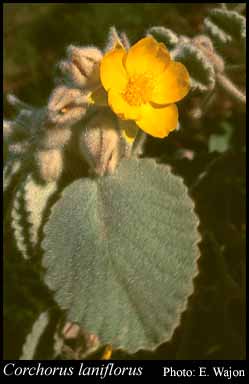- Reference
- Nuytsia 9(3):416-417, Fig. 1 (1994)
- Conservation Code
- Not threatened
- Naturalised Status
- Native to Western Australia
- Name Status
- Current
Spreading or compact shrub, 0.3-0.7(-1.2) m high. Fl. yellow, Mar to Oct. Stony red clay, sandstone. Amongst rocks, drainage lines, gullies.

Scientific Description
Herb or shrub, with hairy stems. Leaves 20-70 mm long, 15-40 mm wide, not lobed; margins crenate; hairy, with stellate hairswith scales absent, Sessile glands absent; stipules present but early deciduous (only visible on youngest leaves), 20 mm long. Perianth clearly of two whorls (calyx and corolla), the corolla obvious and prominent. Pedicel present, 4 mm long; indumentum present, with stellate hairs present, with scales absent. Epicalyx (extra segments or 'bracteoles' immediately below the calyx) absent. Calyx cream or white, 10-15 mm long, the lobes free, Sessile glands absent, stellate hairs present, scales absent, Terminal appendages absent, number of ribs absent. Corolla yellow, 10 mm long, glabrous. Indumentum (outside) Sessile glands absent. Stamens many, free and inserted at the base of the ovary; filaments present, 4 mm long; anthers 0.5 mm long, indumentum absent (anthers glabrous). Staminodes absent, appendages absent. Ovary hairs or scales present, simple hairs absent, stellate hairs present, gland-tipped hairs absent. Flowering time March, April, May, June, July, August, September or October. Distribution Botanical Province Eremaean, IBRA Bioregion Pilbara, Carnarvon, Gascoyne and Little Sandy Desert.
Distribution
- IBRA Regions
- Carnarvon, Gascoyne, Pilbara.
- IBRA Subregions
- Ashburton, Cape Range, Chichester, Fortescue, Hamersley, Roebourne.
- IMCRA Regions
- Pilbara (nearshore).
- Local Government Areas (LGAs)
- Ashburton, Carnarvon, East Pilbara, Karratha, Port Hedland.